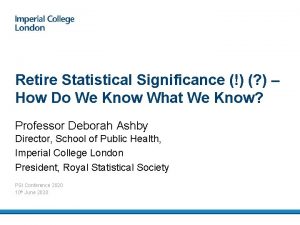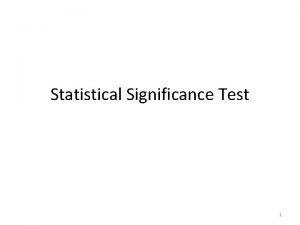Statistical Significance The power of ALPHA The decisive









- Slides: 9

Statistical Significance The power of ALPHA

The decisive value of P is called the significance level. We write it as α, the Greek letter alpha. “Significant” in the statistical sense does not mean “important. ” It means simply “not likely to happen just by chance. ”

Statistical Significance If the P-value is as small as or smaller than alpha, we say that the data are statistically significant at level α. In practice, the most commonly used significance level is: α = 0. 05

To test the hypothesis H 0: μ= μ 0 based on an SRS of size n from a population with unknown mean μ and known standard deviation σ, compute the one-sample z statistic z= x-ℳ σ/√n

Step 1: Hypotheses Identify the population of interest and the parameter you want to draw conclusions about. State hypotheses. Step 2: Conditions Choose the appropriate inference procedure. Verify the conditions for using it. Step 3: Calculations If the conditions are met, carry out the inference procedure. • Calculate the test statistic. Find the P-value. Step 4: Interpretation Interpret your results in the context of the problem. • Interpret the P-value or make a decision about H 0 using statistical significance. Don't forget the 3 C's: conclusion, connection, and context.

reject H 0 or fail to reject H 0 we will reject H 0 if our result is statistically significant at the given α level. That is, we will fail to reject H 0 if our result is not significant at the given α level. EXAMPLE T C E Ho: µ = 0, there is NO difference in job satisfaction between the two work environmen REJ Ho: µ ≠ 0, there is a difference in job satisfaction between the two work environments α =. 05 p =. 0234 Therefore, our hypothesis testing for this particular case is statistically significant at α =. 05

A certain random number generator is supposed to produce random numbers that are uniformly distributed on the interval from 0 to 1. If this is true, the numbers generated come from a population with μ = 0. 5 and σ = 0. 2887. A command to generate 100 random numbers gives outcomes with mean x = 0. 4365. Assume that the population σ remains fixed. We want to test H 0: μ= 0. 5 versus Ha: μ ≠ 0. 5. (a) Calculate the value of the z test statistic and the P-value. (b) Is the result significant at the 5% level (α = 0. 05)? Why or why not? (c) Is the result significant at the 1% level (α = 0. 01)? Why or why not? (d) What decision would you make about H 0 in part (b)? Part (c)? Explain.

(a) Calculate the value of the z test statistic and the P-value. (b) Is the result significant at the 5% level (α = 0. 05)? Why or why not? Since the P-value is less than 0. 05, we say that the result is statistically significant at the 5% level. (c) Is the result significant at the 1% level (α = 0. 01)? Why or why not? Since the P-value is greater than 0. 01, we say that the result is not statistically significant at the 1% level.

(d) What decision would you make about H 0 in part (b)? Part (c)? Explain. At the 5% level, we would reject Ho and conclude that the random number generator does not produce numbers with an average of 0. 5. At the 1% level, we would not reject Ho and conclude that the observed deviation from the mean of 0. 5 is something that could happen by chance. That is, we would conclude that the random number generator is working fine at the 1% level
 Statistical significance p value
Statistical significance p value Retire statistical significance
Retire statistical significance Evanmiller.org ab testing
Evanmiller.org ab testing Decisive action training environment
Decisive action training environment Decisive battles thermopylae
Decisive battles thermopylae Rational inquisitive decisive expressive
Rational inquisitive decisive expressive Gerunds and infinitives as direct objects
Gerunds and infinitives as direct objects Traveling might satisfy your desire for new experiences
Traveling might satisfy your desire for new experiences Jacob kounin quotes
Jacob kounin quotes Dreikurs classroom management theory
Dreikurs classroom management theory

















